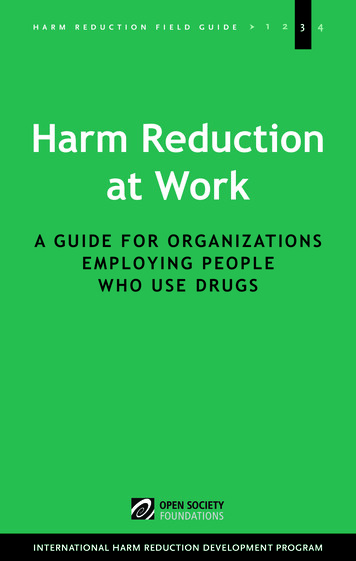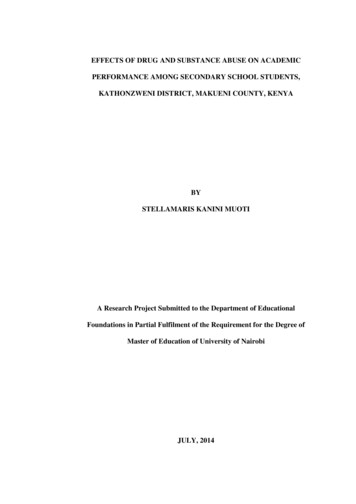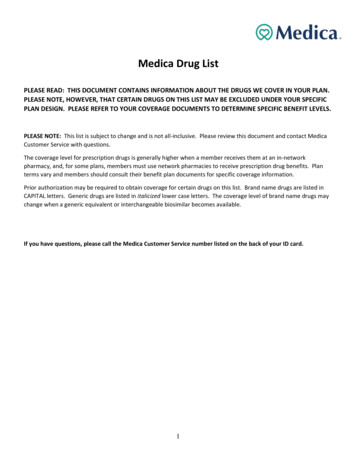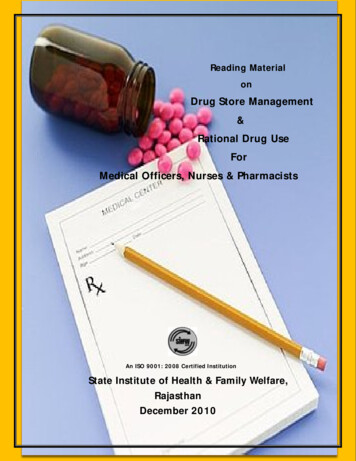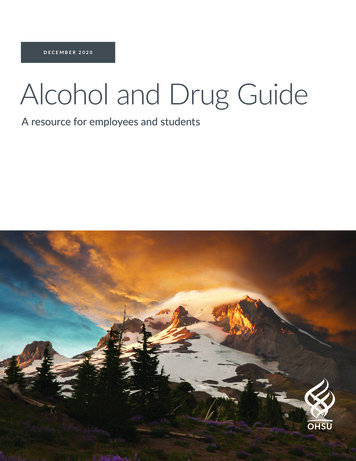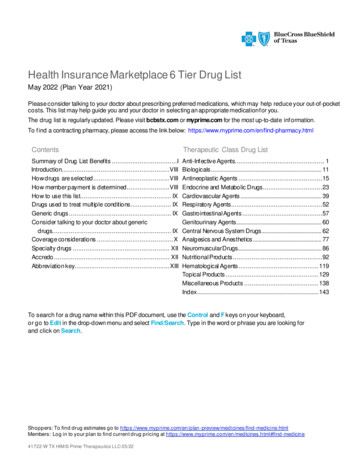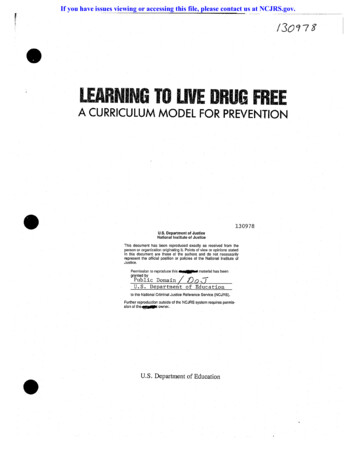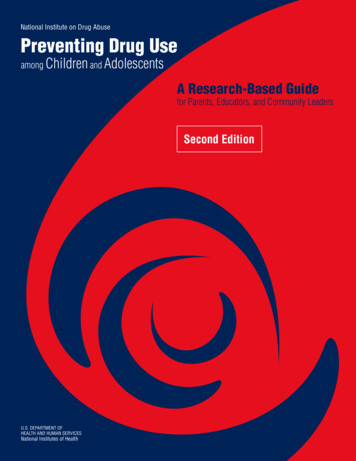
Transcription
AcknowledgmentsNIDA wishes to thank the following individuals for their guidance and comments during the developmentand review of this publication:Karen L. Bierman, Ph.D.Pennsylvania State UniversityHyman Hops, Ph.D.Oregon Research InstituteC. Hendricks Brown, Ph.D.University of South FloridaEugene R. Oetting, Ph.D.Colorado State UniversityRichard R. Clayton, Ph.D.University of KentuckyZili Sloboda, Sc.D.University of AkronThomas J. Dishion, Ph.D.University of OregonRichard Spoth, Ph.D.Iowa State UniversityE. Michael Foster, Ph.D.Pennsylvania State UniversityJohn B. Reid, Ph.D.Oregon Social Learning CenterMeyer D. Glantz, Ph.D.National Institute on Drug AbuseThomas A. Wills, Ph.D.Albert Einstein College of MedicineMark T. Greenberg, Ph.D.Pennsylvania State UniversityNIDA also would like to thank the Community Anti-Drug Coalitions of America for helping organizea focus group of community leaders in reviewing this publication.This publication was written by Elizabeth B. Robertson, Ph.D., Susan L. David, M.P.H. (retired), andSuman A. Rao, Ph.D., National Institute on Drug Abuse.All materials in this volume are in the public domain and may be used or reproduced without permissionfrom NIDA or the authors. Citation of the source is appreciated.The U.S. government does not endorse or favor any specific commercial product or company.Trade, proprietary, or company names appearing in the publication are used only because theyare considered essential in the context of the studies described here.NIH Publication No. 04-4212(A)Printed 1997Reprinted 1997, 1999, 2001Second Edition October 2003iiPreventing Drug Use among Children and Adolescents
ention Principles2Chapter 1: Risk Factors and Protective Factors6What are risk factors and protective factors?6What are the early signs of risk that may predict later drug abuse?8What are the highest risk periods for drug abuse among youth?9When and how does drug abuse start and progress?10Chapter 2: Planning for Drug Abuse Prevention in the Community12How can the community develop a plan for research-based prevention?12How can the community use the prevention principles in prevention planning?12How can the community assess the level of risk for drug abuse?14Is the community ready for prevention?15How can the community be motivated to implement research-based prevention programs?16How can the community assess the effectiveness of current prevention efforts?17Chapter 3: Applying Prevention Principles to Drug Abuse Prevention Programs18How are risk and protective factors addressed in prevention programs?18What are the core elements of effective research-based prevention programs?21How can the community implement and sustain effective prevention programs?24How can the community evaluate the impact of its program on drug abuse?24What are the cost-benefits of community prevention programs?25National Institute on Drug Abuseiii
Chapter 4: Examples of Research-Based Drug Abuse Prevention ProgramsUniversal Programs2626Elementary School Caring School Community Program Classroom-Centered (CC) and Family-School Partnership (FSP) Intervention Promoting Alternative Thinking Strategies (PATHS) Skills, Opportunity, And Recognition (SOAR)Middle School Guiding Good Choices Life Skills Training (LST) Program Lions-Quest Skills for Adolescence (SFA) Project ALERT Project STAR The Strengthening Families Program: For Parents and Youth 10–14 (SFP 10–14)High School Life Skills Training: Booster Program Lions-Quest Skills for Adolescence Project ALERT Plus The Strengthening Families Program: For Parents and Youth 10–14Selective Programs31Elementary School Focus on Families (FOF) The Strengthening Families Program (SFP)Middle School Coping PowerHigh School Adolescents Training and Learning to Avoid Steroids (ATLAS)Indicated Programs33High School Project Towards No Drug Abuse (Project TND) Reconnecting Youth Program (RY)Tiered Programs34Elementary School Early Risers “Skills for Success” Risk Prevention Program Fast Track Prevention Trial for Conduct ProblemsMiddle School Adolescent Transitions Program (ATP)Chapter 5: Selected Resources and Referencesiv36Selected Resources36Selected References38Preventing Drug Use among Children and Adolescents
PrefaceToday’s youth face many risks, including drug abuse,violence, and HIV/AIDS. Responding to these risksbefore they become problems can be difficult. Oneof the goals of the National Institute on Drug Abuse(NIDA) is to help the public understand the causesof drug abuse and to prevent its onset. Drug abusehas serious consequences in our homes, schools,and communities. From NIDA’s perspective, theuse of all illicit drugs and the inappropriate use oflicit drugs is considered drug abuse.Prevention science has made great progress in recentyears. Many prevention interventions are being testedin “real-world” settings so they can be more easilyadapted for community use. Scientists are studyinga broader range of populations and topics. Theyhave identified, for example, effective interventionswith younger populations to help prevent riskbehaviors before drug abuse occurs.Researchers are also studying older teens whoare already using drugs to find ways to preventfurther abuse or addiction. Practical issues, such ascost-benefit analyses, are being studied. Presentingthese findings to the public is one of NIDA’s mostimportant responsibilities.We are pleased to offer our newest edition of thepublication, Preventing Drug Use among Childrenand Adolescents: A Research-Based Guide for Parents,Educators, and Community Leaders, Second Edition.This edition includes updated principles, new questionsand answers, new program information, and expandedreferences and resources. We also invite you tovisit our Web site at www.drugabuse.gov wherethis publication and other materials related to theconsequences, prevention, and treatment of drugabuse are offered. We hope that you will find theguide useful and helpful to your work.Nora D. Volkow, M.D.DirectorNational Institute on Drug AbuseNational Institute on Drug Abusev
IntroductionIn 1997, the National Institute on Drug Abuse (NIDA)published the first edition of Preventing Drug Useamong Children and Adolescents: A Research-BasedGuide to share the latest NIDA-funded preventionresearch findings with parents, educators, andcommunity leaders. The guide introduced the conceptof “research-based prevention” with questions andanswers on risk and protective factors, communityplanning and implementation, and 14 preventionprinciples derived from effective drug abuse preventionresearch. Examples of research-tested preventionprograms were also featured. The purpose was to helpprevention practitioners use the results of preventionresearch to address drug abuse among children andadolescents in communities across the country.This second edition, reflecting NIDA’s expandedresearch program and knowledge base, is more thandouble the size of the first edition. The preventionprinciples have been expanded to provide moreunderstanding about the latest research, and principlesrelevant to each chapter accompany the discussion.Additional questions and answers, a new chapteron community planning, and more informationon the core elements in research-based preventionprograms have been added. Each chapter ends witha “Community Action Box” for primary readers—parents, educators, and community leaders. As in thefirst edition, the descriptions of prevention programsare presented as examples of research-basedprograms currently available.Since then, NIDA’s prevention research program hasmore than doubled in size and scope to address allstages of child development, a mix of audiences andsettings, and the delivery of effective services at thecommunity level. The Institute now focuses on risksfor drug abuse and other problem behaviors thatoccur throughout a child’s development. Preventioninterventions designed and tested to address risks canhelp children at every step along their developmentalpath. Working more broadly with families, schools,and communities, scientists have found effective waysto help people gain the skills and approaches to stopproblem behaviors before they occur. Research fundedby NIDA and other Federal research organizations—such as the National Institute of Mental Health andthe Centers for Disease Control and Prevention—shows that early intervention can prevent manyadolescent risk behaviors.The expanded Selected Resources section offers Websites, sponsored by Federal and private-sector agencies.Some feature registries of effective preventionprograms with agency-specific selection criteriaand other resources for community planning. TheSelected References section includes up-to-date booksand journal articles that provide more informationon prevention research. NIDA hopes that this revisedguide is helpful to drug abuse prevention efforts amongchildren and adolescents in homes, schools, andcommunities nationwide.National Institute on Drug Abuse1
Prevention PrinciplesThese revised prevention principles have emerged from research studies funded by NIDA on the origins of drugabuse behaviors and the common elements found in research on effective prevention programs. Parents, educators,and community leaders can use these principles to help guide their thinking, planning, selection, and delivery ofdrug abuse prevention programs at the community level. The references following each principle are representativeof current research.Risk Factors and Protective FactorsPrevention programs shouldenhance protective factors and reverse or reducerisk factors (Hawkins et al. 2002).PRINCIPLE 1 The risk of becoming a drug abuser involves therelationship among the number and type ofrisk factors (e.g., deviant attitudes and behaviors)and protective factors (e.g., parental support)(Wills and McNamara et al. 1996). The potential impact of specific risk andprotective factors changes with age. Forexample, risk factors within the family havegreater impact on a younger child, whileassociation with drug-abusing peers may be amore significant risk factor for an adolescent(Gerstein and Green 1993; Kumpfer et al. 1998). Early intervention with risk factors (e.g.,aggressive behavior and poor self-control)often has a greater impact than laterintervention by changing a child’s life path(trajectory) away from problems and towardpositive behaviors (Ialongo et al. 2001).2Preventing Drug Use among Children and Adolescents While risk and protective factors can affectpeople of all groups, these factors can havea different effect depending on a person’s age,gender, ethnicity, culture, and environment(Beauvais et al. 1996; Moon et al. 1999).Prevention programs should addressall forms of drug abuse, alone or in combination,including the underage use of legal drugs (e.g.,tobacco or alcohol); the use of illegal drugs (e.g.,marijuana or heroin); and the inappropriate useof legally obtained substances (e.g., inhalants),prescription medications, or over-the-counterdrugs (Johnston et al. 2002).PRINCIPLE 2Prevention programs shouldaddress the type of drug abuse problem in thelocal community, target modifiable risk factors,and strengthen identified protective factors(Hawkins et al. 2002).PRINCIPLE 3Prevention programs should betailored to address risks specific to populationor audience characteristics, such as age, gender,and ethnicity, to improve program effectiveness(Oetting et al. 1997).PRINCIPLE 4
Prevention PlanningSchool ProgramsFamily ProgramsPrevention programs can bedesigned to intervene as early as preschoolto address risk factors for drug abuse, suchas aggressive behavior, poor social skills, andacademic difficulties (Webster-Stratton 1998;Webster-Stratton et al. 2001).Family-based prevention programsshould enhance family bonding and relationshipsand include parenting skills; practice in developing,discussing, and enforcing family policies onsubstance abuse; and training in drug educationand information (Ashery et al. 1998).PRINCIPLE 5Family bonding is the bedrock of the relationshipbetween parents and children. Bonding canbe strengthened through skills training onparent supportiveness of children, parent-childcommunication, and parental involvement(Kosterman et al. 1997). Parental monitoring and supervision arecritical for drug abuse prevention. These skillscan be enhanced with training on rule-setting;techniques for monitoring activities; praisefor appropriate behavior; and moderate,consistent discipline that enforces definedfamily rules (Kosterman et al. 2001). Drug education and information for parentsor caregivers reinforces what childrenare learning about the harmful effects ofdrugs and opens opportunities for familydiscussions about the abuse of legal andillegal substances (Bauman et al. 2001). Brief, family-focused interventions for thegeneral population can positively changespecific parenting behavior that can reducelater risks of drug abuse (Spoth et al. 2002b).PRINCIPLE 6Prevention programs for elementaryschool children should target improving academicand social-emotional learning to address riskfactors for drug abuse, such as early aggression,academic failure, and school dropout. Educationshould focus on the following skills (Ialongoet al. 2001; Conduct Problems Prevention WorkGroup 2002b):PRINCIPLE 7 self-control; emotional awareness; communication; social problem-solving; and academic support, especially in reading.Prevention programs for middle orjunior high and high school students should increaseacademic and social competence with the followingPRINCIPLE 8skills (Botvin et al.1995; Scheier et al. 1999): study habits and academic support; communication; peer relationships; self-efficacy and assertiveness; drug resistance skills; reinforcement of antidrug attitudes; and strengthening of personal commitmentsagainst drug abuse.National Institute on Drug Abuse3
Community ProgramsPrevention Program DeliveryPrevention programs aimed atgeneral populations at key transition points, suchas the transition to middle school, can producebeneficial effects even among high-risk familiesand children. Such interventions do not singleout risk populations and, therefore, reduce labelingand promote bonding to school and community(Botvin et al. 1995; Dishion et al. 2002).When communities adapt programsto match their needs, community norms, ordiffering cultural requirements, they should retaincore elements of the original research-basedintervention (Spoth et al. 2002b), which include:Community prevention programsthat combine two or more effective programs,such as family-based and school-basedprograms, can be more effective than a singleprogram alone (Battistich et al. 1997). Content (the information, skills, and strategiesof the program); andPRINCIPLE 9PRINCIPLE 10PRINCIPLE 12 Structure (how the program is organizedand constructed); Delivery (how the program is adapted,implemented, and evaluated).Prevention programs should belong-term with repeated interventions (i.e.,booster programs) to reinforce the originalprevention goals. Research shows that thebenefits from middle school prevention programsdiminish without followup programs in highschool (Scheier et al. 1999).PRINCIPLE 13Community prevention programsreaching populations in multiple settings—forexample, schools, clubs, faith-based organizations,and the media—are most effective when theypresent consistent, community-wide messagesin each setting (Chou et al. 1998).PRINCIPLE 114Preventing Drug Use among Children and Adolescents
Prevention programs should includeteacher training on good classroom managementpractices, such as rewarding appropriate studentbehavior. Such techniques help to foster students’positive behavior, achievement, academic motivation,and school bonding (Ialongo et al. 2001).PRINCIPLE 14Prevention programs are mosteffective when they employ interactive techniques,such as peer discussion groups and parentrole-playing, that allow for active involvement inlearning about drug abuse and reinforcing skillsPRINCIPLE 15(Botvin et al. 1995).Research-based prevention programscan be cost-effective. Similar to earlier research,recent research shows that for each dollar investedin prevention, a savings of up to 10 in treatmentfor alcohol or other substance abuse can be seen(Pentz 1998; Hawkins 1999; Aos et al. 2001;Spoth et al. 2002a).PRINCIPLE 16National Institute on Drug Abuse5
Chapter 1: Risk Factors and Protective FactorsThis chapter describes how risk and protective factors influence drug abuse behaviors, the early signs of risk,transitions as high-risk periods, and general patterns of drug abuse among children and adolescents. A majorfocus is how prevention programs can strengthen protection or intervene to reduce risks.What are risk factorsand protective factors?actions, this behavior can lead to additional riskswhen the child enters school. Aggressive behaviorin school can lead to rejection by peers, punishmentby teachers, and academic failure. Again, if notaddressed through preventive interventions, theserisks can lead to the most immediate behaviors thatput a child at risk for drug abuse, such as skippingschool and associating with peers who abuse drugs. Infocusing on the risk path, research-based preventionprograms can intervene early in a child’s developmentto strengthen protective factors and reduce risks longbefore problem behaviors develop.Studies over the past two decades have tried todetermine the origins and pathways of drug abuseand addiction—how the problem starts and how itprogresses. Many factors have been identified thathelp differentiate those more likely to abuse drugsfrom those less vulnerable to drug abuse. Factorsassociated with greater potential for drug abuse arecalled “risk” factors, while those associated withreduced potential for abuse are called “protective”factors. Please note, however, that most individualsat risk for drug abuse do not start using drugs orbecome addicted. Also, a risk factor for one personmay not be for another.The table below provides a framework forcharacterizing risk and protective factors in fivedomains, or settings. These domains can then serveas a focus for prevention. As the first two examplessuggest, some risk and protective factors are mutuallyexclusive—the presence of one means the absenceof the other. For example, in the Individual domain,early aggressive behavior, a risk factor, indicates theabsence of impulse control, a key protective factor.Helping a young child learn to control impulsivebehavior is a focus of some prevention programs.As discussed in the Introduction, risk and protectivefactors can affect children in a developmental risktrajectory, or path. This path captures how risksbecome evident at different stages of a child’s life.For example, early risks, such as out-of-controlaggressive behavior, may be seen in a very youngchild. If not addressed through positive parental6Risk FactorsDomainProtective FactorsEarly Aggressive BehaviorIndividualImpulse ControlLack of Parental SupervisionFamilyParental MonitoringSubstance AbusePeerAcademic CompetenceDrug AvailabilitySchoolAntidrug Use PoliciesPovertyCommunityStrong Neighborhood AttachmentPreventing Drug Use among Children and Adolescents
Other risk and protective factors are independent ofeach other, as demonstrated in the table as examplesin the peer, school, and community domains. Forexample, in the school domain, drugs may beavailable, even though the school has “antidrugpolicies.” An intervention may be to strengthenenforcement so that school policies create theintended school environment.Risk factors for drug abuse represent challengesto an individual’s emotional, social, and academicdevelopment. These risk factors can produce differenteffects, depending on the individual’s personalitytraits, phase of development, and environment.For instance, many serious risks, such as earlyaggressive behavior and poor academic achievement,may indicate that a young child is on a negativedevelopmental path headed toward problem behavior.Early intervention, however, can help reduce or reversethese risks and change that child’s developmental path.For young children already exhibitingserious risk factors, delaying interventionuntil adolescence will likely make it moredifficult to overcome risks. By adolescence,children’s attitudes and behaviors are wellestablished and not easily changed.Risk factors can influence drug abuse in severalways. They may be additive: The more risks achild is exposed to, the more likely the child willabuse drugs. Some risk factors are particularlypotent, yet may not influence drug abuse unlesscertain conditions prevail. Having a family historyof substance abuse, for example, puts a child atrisk for drug abuse. However, in an environmentwith no drug-abusing peers and strong antidrugnorms, that child is less likely to become a drugabuser. And the presence of many protectivefactors can lessen the impact of a few risk factors.For example, strong protection—such as parentalsupport and involvement—can reduce the influenceof strong risks, such as having substance-abusingpeers. An important goal of prevention, then,Chapter 1 PrinciplesRisk Factors andProtective FactorsPRINCIPLE 1Prevention programs should enhanceprotective factors and reverse or reduce risk factors. The risk of becoming a drug abuser involves therelationship among the number and type of risk factors(e.g., deviant attitudes and behaviors) and protectivefactors (e.g., parental support). The potential impact of specific risk and protectivefactors changes with age. For example, risk factorswithin the family have greater impact on a youngerchild, while association with drug-abusing peers maybe a more significant risk factor for an adolescent. Early intervention with risk factors (e.g., aggressivebehavior and poor self-control) often has a greaterimpact than later intervention by changing a child’slife path (trajectory) away from problems and towardpositive behaviors. While risk and protective factors can affect people ofall groups, these factors can have a different effectdepending on a person’s age, gender, ethnicity, culture,and environment.PRINCIPLE 2Prevention programs should address allforms of drug abuse, alone or in combination, includingthe underage use of legal drugs (e.g., tobacco or alcohol);the use of illegal drugs (e.g., marijuana or heroin); and theinappropriate use of legally obtained substances (e.g., inhalants),prescription medications, or over-the-counter drugs.PRINCIPLE 3Prevention programs should address thetype of drug abuse problem in the local community, targetmodifiable risk factors, and strengthen identifiedprotective factors.PRINCIPLE 4Prevention programs should be tailoredto address risks specific to population or audiencecharacteristics, such as age, gender, and ethnicity,to improve program effectiveness.is to change the balance between risk andprotective factors so that protective factorsoutweigh risk factors.National Institute on Drug Abuse7
Gender may also determine how an individualresponds to risk factors. Research on relationshipswithin the family shows that adolescent girls respondpositively to parental support and discipline, whileadolescent boys sometimes respond negatively.Research on early risk behaviors in the school settingshows that aggressive behavior in boys and learningdifficulties in girls are the primary causes of poor peerrelationships. These poor relationships, in turn, canlead to social rejection, a negative school experience,and problem behaviors including drug abuse.In the FamilyChildren’s earliest interactions occur within thefamily and can be positive or negative. For thisreason, factors that affect early development in thefamily are probably the most crucial. Children aremore likely to experience risk when there is: lack of mutual attachment and nurturingby parents or caregivers; ineffective parenting; a chaotic home environment;What are the early signs of risk thatmay predict later drug abuse? lack of a significant relationship witha caring adult; andSome signs of risk can be seen as early as infancy.Children’s personality traits or temperament canplace them at increased risk for later drug abuse.Withdrawn and aggressive boys, for example, oftenexhibit problem behaviors in interactions with theirfamilies, peers, and others they encounter in socialsettings. If these behaviors continue, they will likelylead to other risks. These risks can include academicfailure, early peer rejection, and later affiliation withdeviant peers, often the most immediate risk for drugabuse in adolescence. Studies have shown that childrenwith poor academic performance and inappropriatesocial behavior at ages 7 to 9 are more likely to beinvolved with substance abuse by age 14 or 15. a caregiver who abuses substances, suffers frommental illness, or engages in criminal behavior.These experiences, especially the abuse of drugs andother substances by parents and other caregivers, canimpede bonding to the family and threaten feelings ofsecurity that children need for healthy development.On the other hand, families can serve a protectivefunction when there is: a strong bond between children and their families; parental involvement in a child’s life; supportive parenting that meets financial,emotional, cognitive, and social needs; and clear limits and consistent enforcement of discipline.Finally, critical or sensitive periods in developmentmay heighten the importance of risk or protectivefactors. For example, mutual attachment and bondingbetween parents and children usually occurs in infancyand early childhood. If it fails to occur during thosedevelopmental stages, it is unlikely that a strong positiveattachment will develop later in the child’s life.8Preventing Drug Use among Children and Adolescents
Outside the FamilyOther risk factors relate to the quality of children’srelationships in settings outside the family, such asin their schools, with their peers, teachers, and inthe community. Difficulties in these settings can becrucial to a child’s emotional, cognitive, and socialdevelopment. Some of these risk factors are: inappropriate classroom behavior, suchas aggression and impulsivity; academic failure; poor social coping skills; association with peers with problem behaviors,including drug abuse; and misperceptions of the extent and acceptabilityof drug-abusing behaviors in school, peer, andcommunity environments.Association with drug-abusing peers is often themost immediate risk for exposing adolescents todrug abuse and delinquent behavior. Research hasshown, however, that addressing such behavior ininterventions can be challenging. For example, arecent study (Dishion et al. 2002) found that placinghigh-risk youth in a peer group intervention resultedin negative outcomes. Current research is exploringthe role that adults and positive peers can play inhelping to avoid such outcomes in future interventions.Other factors—such as drug availability, drugtrafficking patterns, and beliefs that drug abuse isgenerally tolerated—are also risks that can influenceyoung people to start to abuse drugs.Family has an important role in providing protectionfor children when they are involved in activitiesoutside the family. When children are outside thefamily setting, the most salient protective factors are: age-appropriate parental monitoring of socialbehavior, including establishing curfews, ensuringadult supervision of activities outside the home,knowing the child’s friends, and enforcinghousehold rules; success in academics and involvementin extracurricular activities; strong bonds with prosocial institutions, suchas school and religious institutions; and acceptance of conventional norms againstdrug abuse.What are the highest risk periodsfor drug abuse among youth?Research has shown that the key risk periodsfor drug abuse occur during major transitions inchildren’s lives. These transitions include significantchanges in physical development (for example,puberty) or social situations (such as movingor parents divorcing) when children experienceheightened vulnerability for problem behaviors.The first big transition for children is when they leavethe security of the family and enter school. Later,when they advance from elementary school to middleor junior high school, they often experience newacademic and social situations, such as learning toget along with a wider group of peers and havinggreater expectations for academic performance. Itis at this stage—early adolescence—that childrenare likely to encounter drug abuse for the first time.National Institute on Drug Abuse9
Then, when they enter high school, young people faceadditional social, psychological, and educationalchallenges. At the same time, they may be exposedto greater availability of drugs, drug abusers, andsocial engagements involving drugs. These challengescan increase the risk that they will abuse alcohol,tobacco, and other drugs.A particularly challenging situation in late adolescenceis moving away from home for the first time withoutparental supervision, perhaps to attend college orother schooling. Substance abuse, particularly ofalcohol, remains a major public health problem forcollege populations.When young adults enter the workforce or marry,they again confront new challenges
guide is helpful to drug abuse prevention efforts among children and adolescents in homes, schools, and communities nationwide. Introduction 1. Prevention Principles These revised prevention principles have emerged from research studi

